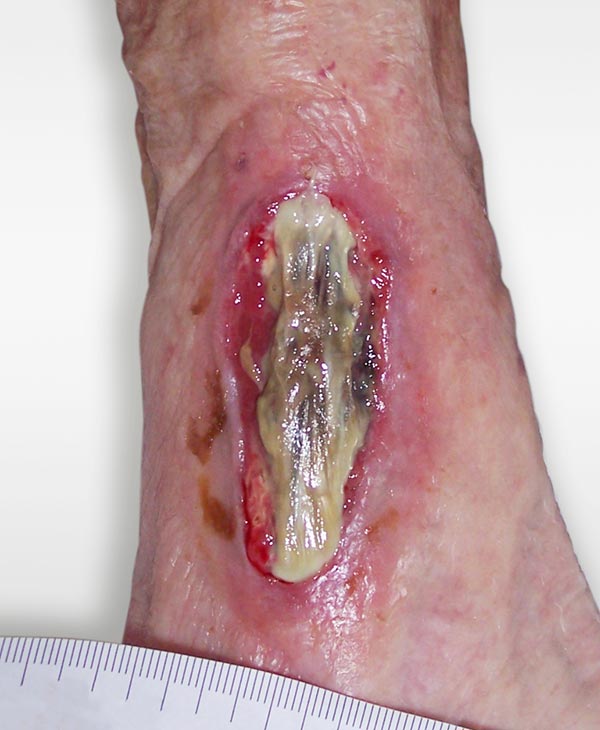What are the 4 main odour grades
on the Baker and Haig Scale?
The Baker and Haig Scale was created to mitigate some of the difficulties healthcare professionals experience when assessing wound malodour. The more difficult a symptom is to assess, the higher the chances are that it will be improperly managed.
When determining the type of intervention needed to ensure good patient outcomes, using the Baker and Haig malodour scale as part of a wider holistic assessment of the wound can be beneficial.
What are the issues associated with wound malodour?
Malodour is notoriously challenging for both patients and healthcare professionals to navigate sensitively and effectively.[1]
Malodour can have a considerable impact on a patient’s quality of life. Patients report that even temporary bouts of wound malodour cause discomfort and embarrassment.[2]
Continuous malodour, usually associated with chronic and slow-healing wounds (i.e., ulcers), can have more problematic long-term consequences such as altered body image, shame, and isolation.[3]
As our sense of smell and taste are intrinsically linked, prolonged malodour can lead to nausea and a loss of appetite.[4] This can be particularly detrimental to the patient, as one of the key aspects of wound healing is ensuring adequate nutrition.
Why is malodour difficult to assess?
One of the fundamental challenges of assessing malodour is recognising that it can be subjective. This is because the sense of smell varies from person to person.[5]
This means that even if they are using the same scale, different healthcare professionals may not classify malodour in the same way.
It is also important to be conscious that malodour is often a normal part of the wound healing process. Malodour is not always indicative of any issues with the patient or a more serious underlying problem such as infection.[6]
Although a bacterial infection may be responsible for malodour, it is also true that some wounds have a distinctive smell.[7]
It is critical to accurately differentiate between a normal, albeit unpleasant, odour and one that points to a problem.
As such, all assessments of malodour should take a patient wellbeing-first approach. This means that even if wound malodour is not necessarily indicative of infection, the emotional impact of the odour on the patient should still be addressed as a matter of priority.
How do Baker and Haig grade malodour?
Strong
Odour is evident upon entering a room. This means that you can smell the odour from 6 to 10 feet away from a patient wearing a conventional dressing.
Moderate
Odour is evident upon entering the room. This means that you can smell the odour when you are standing 6 to 10 feet away from a patient who is not wearing a dressing.
Slight
Odour is evident when you are standing close to the patient, and they are not wearing a dressing.
No Odour
There is no discernible odour, even when near the patient with an uncovered wound.
What are the limitations of the Baker and Haig scale?
The Baker and Haig scale cannot be used as a conclusive diagnostic tool. The scale does not identify the root cause of the malodour, nor does it prescribe any solutions to help manage it.
The Baker and Haig scale descriptions are somewhat broad. As smell is largely subjective, the patient’s clinicians and caregivers may find it difficult to come to a unanimous verdict on the severity of the odour.
One of the most significant limitations of the Baker and Haig scale is that it does not measure the effect of the malodour on the patient’s wellbeing. This means that a healthcare professional may need to conduct a separate evaluation of the malodour’s effect on the patient’s quality of life and adjust any treatments accordingly.
References:
- David, Mellar P., Samala, Renato V. et al. Comprehensive Wound Management: Win the Race. Cleveland Clinical Journal of Medicine 2015; 82(8): 535
- Akhmetova, Alma. A Comprehensive Review of Topical Odor-Controlling Treatment Options for Chronic Wounds. J Wound Ostomy Continence Nurs 2016; 46 (6): 598
- Berke, Christine, Black, Joyce,. Top Ten Tips: Managing Wound Odour. Wounds International 2020; 11(4): 8
- Fletcher, Jacqui. Malodorous Wounds: Assessment and Management. Wound Essentials 2008; 3: 15
- Ibid: 14
- Ibid: 14
- Berke, Christine, Black, Joyce. Top Ten Tips: Managing Wound Odour. Wounds International 2020; 11(4): 8
- Ibid: 8
Resources:
Product website:
Other related articles:
Disclaimer:
Please note that while every effort is made to ensure the accuracy of the content presented, it is purely for educational purposes only and is not a substitute for professional medical advice.


